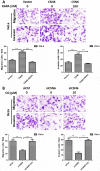CSN6 Promotes the Migration and Invasion of Cervical Cancer Cells by Inhibiting Autophagic Degradation of Cathepsin L
- PMID: 31223289
- PMCID: PMC6567803
- DOI: 10.7150/ijbs.32987
CSN6 Promotes the Migration and Invasion of Cervical Cancer Cells by Inhibiting Autophagic Degradation of Cathepsin L
Abstract
CSN6 is one subunit of the highly conserved constitutive photomorphogenesis 9 (COP9) signalosome (CSN), which is overexpressed in many types of cancers, and has received great attention as a regulator of the degradation of cancer-related proteins, suggesting its importance in oncogenic activity. CSN6 has been shown to be overexpressed in cervical cancer (CC) and associated with CC development. CC remains to be one of the most aggressive cancers affecting women. Cathepsin L (CTSL), significantly associated with the autophagy, plays a critical role in degradation of extracellular matrix for metastasis. However, the detailed biological functions of CSN6 on CTSL in CC metastasis have not been well clarified. Our data has shown that CSN6 and CTSL are positively correlated. The overexpression of CSN6 and CTSL might be a strong indicator for CC enhanced aggressiveness. CSN6 could suppress the degradation of CTSL, then facilitated the migration and invasion of CC cells. Interestingly, our results indicated that autophagy is essential for decreasing CTSL, while CSN6 could inhibit the autophagy ability of CC cells. In addition, blocking of the mammalian target of rapamycin (mTOR) pathway reversed CSN6-mediated autophagy inhibition. We further demonstrated that CSN6 positively regulated CTSL expression through an autophagy-lysosomal system. Taken together, we concluded that CSN6 might promote the migration and invasion of cervical cancer cells by inhibiting autophagic degradation of CTSL and serve as a potential gene therapy target for the treatment of CC metastasis.
Keywords: CSN6; CTSL; autophagy; cervical cancer; metastasis.
Conflict of interest statement
Competing Interests: The authors have declared that no competing interest exists.
Figures










Similar articles
-
CSN6: a promising target for cancer prevention and therapy.Histol Histopathol. 2020 Jul;35(7):645-652. doi: 10.14670/HH-18-206. Epub 2020 Feb 4. Histol Histopathol. 2020. PMID: 32016946 Review.
-
CSN6 controls the proliferation and metastasis of glioblastoma by CHIP-mediated degradation of EGFR.Oncogene. 2017 Feb 23;36(8):1134-1144. doi: 10.1038/onc.2016.280. Epub 2016 Aug 22. Oncogene. 2017. PMID: 27546621
-
Downregulation of CSN6 attenuates papillary thyroid carcinoma progression by reducing Wnt/β-catenin signaling and sensitizes cancer cells to FH535 therapy.Cancer Med. 2018 Feb;7(2):285-296. doi: 10.1002/cam4.1272. Epub 2018 Jan 17. Cancer Med. 2018. PMID: 29341469 Free PMC article.
-
CSN6 promotes the cell migration of breast cancer cells by positively regulating Snail1 stability.Int J Med Sci. 2020 Oct 1;17(17):2809-2818. doi: 10.7150/ijms.50206. eCollection 2020. Int J Med Sci. 2020. PMID: 33162808 Free PMC article.
-
The Emerging Role of CSN6 in Biological Behavior and Cancer Progress.Anticancer Agents Med Chem. 2019;19(10):1198-1204. doi: 10.2174/1871520619666190408142131. Anticancer Agents Med Chem. 2019. PMID: 30961513 Review.
Cited by
-
The role of ubiquitination and deubiquitination in tumor invasion and metastasis.Int J Biol Sci. 2022 Mar 6;18(6):2292-2303. doi: 10.7150/ijbs.69411. eCollection 2022. Int J Biol Sci. 2022. PMID: 35414786 Free PMC article. Review.
-
The role of ubiquitination in health and disease.MedComm (2020). 2024 Sep 25;5(10):e736. doi: 10.1002/mco2.736. eCollection 2024 Oct. MedComm (2020). 2024. PMID: 39329019 Free PMC article. Review.
-
CSN6: a promising target for cancer prevention and therapy.Histol Histopathol. 2020 Jul;35(7):645-652. doi: 10.14670/HH-18-206. Epub 2020 Feb 4. Histol Histopathol. 2020. PMID: 32016946 Review.
-
Molecular mechanisms underlying the inhibition of cell migration and invasion in endometriosis: Advances in pharmacological research (Review).Biomed Rep. 2025 Jul 8;23(3):152. doi: 10.3892/br.2025.2030. eCollection 2025 Sep. Biomed Rep. 2025. PMID: 40704280 Free PMC article. Review.
-
The Role of Deubiquitinating Enzymes in the Various Forms of Autophagy.Int J Mol Sci. 2020 Jun 12;21(12):4196. doi: 10.3390/ijms21124196. Int J Mol Sci. 2020. PMID: 32545524 Free PMC article. Review.

